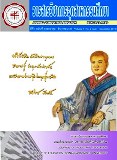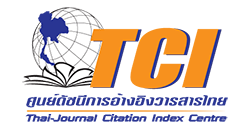การผลิตถ่านอัดแท่งจากถ่านกะลามะพร้าวและถ่านเหง้ามันสำปะหลัง
Abstract
บทคัดย่อ การวิจัยนี้มีจุดมุ่งหมายเพื่อ ศึกษาการผลิตถ่านอัดแท่งจากถ่านกะลามะพร้าวและถ่านเหง้ามันสำปะหลัง โดยทำการทดสอบสมรรถนะทางความร้อนตามเกณฑ์มาตรฐานผลิตภัณฑ์ชุมชุน (มผช. 238/2547) มลภาวะ ต้นทุนต่อหน่วย และผลตอบแทนทางเศรษฐศาสตร์จากการผลิตถ่านอัดแท่ง ผู้วิจัยทำการวิเคราะห์และนำวัสดุทั้ง 2 ชนิดดังกล่าวมาผสมกัน ใน 5 อัตราส่วน โดยกำหนดรูปทรงมีลักษณะรูกลวง เส้นผ่าศูนย์กลางรูกลวง 1.5 เซนติเมตร ความยาว 10 เซนติเมตร และถ่านอัดแท่งรูปทรงกระบอกมีครีบ 5 ครีบรอบด้าน ขนาดเส้นผ่าศูนย์กลาง 5 เซนติเมตร ปริมาณความชื้นไม่เกินร้อยละ 8 ของน้ำหนัก และแรงอัด 33 กิโลกรัมต่อตารางเซนติเมตร ตามขอบเขตที่กำหนด และทำการทดสอบวัดผลในห้องปฏิบัติการทดสอบเพื่อส่งให้ผู้เชี่ยวชาญประเมินค่าสมรรถนะทางความร้อนและความเหมาะสมในการนำมาใช้งาน ผลการทดสอบวิเคราะห์สมรรถนะจากห้องปฏิบัติการ พบว่า อัตราส่วนผสมระหว่าง ถ่านอัดแท่งกะลามะพร้าว 9 ส่วน ต่อ ถ่านเหง้ามันสำปะหลัง 1 ส่วน เป็นอัตราส่วนที่ให้ค่าความร้อนสูงสุด 6,580.10 1 กิโลแคลอรี่/กิโลกรัม ประกอบด้วย สารที่เผาไหม้ได้ 85 % ปริมาณคาร์บอนคงตัว 0.14 % ปริมาณเถ้า 14.03 % และปริมาณความชื้น 1.04 % ผลการทดสอบมลภาวะจากปริมาณก๊าซ 4 ชนิด ประกอบด้วย ก๊าซซัลเฟอร์ไดออกไซด์ มีปริมาณเท่ากับ 195 ppm ก๊าซไนโตรเจนไดออกไซด์ เท่ากับ 26 ppm คาร์บอนไดออกไซด์ 9.11 ppm และก๊าซคาร์บอนมอนอกไซด์ มีปริมาณมากกว่า 4,000 ppm มีการเปลี่ยนแปลงโดยมีค่าลดลง สัมพันธ์กับปริมาณคงเหลือของเนื้อวัสดุหลังการเผาไหม้ ซึ่งในด้านสมรรถนะเป็นไปตามเกณฑ์มาตรฐานผลิตภัณฑ์ชุมชุน (มผช. 238/2547) ผลการวิเคราะห์ความคุ้มค่าทางเศรษฐศาสตร์ของการผลิตถ่านอัดแท่งจากถ่านกะลามะพร้าวและถ่านเหง้ามันสำปะหลัง พบว่า อัตราส่วนผสมระหว่าง ถ่านกะลามะพร้าว 3 ส่วน ต่อ ถ่านเหง้ามันสำปะหลัง 7 ส่วน จะให้ค่าความร้อน เท่ากับ 5,003 กิโลแคลอรี/กิโลกรัม มีค่าความชื้นต่ำกว่า ร้อยละ 8 และมีสมรรถนะเป็นไปตามเกณฑ์มาตรฐานจะมีต้นทุนการผลิตต่ำสุด เท่ากับ 4.80 บาทต่อกิโลกรัม และเมื่อกำลังการผลิตที่ 400 กิโลกรัมต่อวัน จะสามารถคืนทุนได้ภายในระยะเวลาประมาณ 0.7 ปี (8 เดือน 12 วัน) ซึ่งผลการศึกษาวิจัยสามารถนำไปส่งเสริมให้เกษตรกรนำวัสดุเหลือใช้ทางการเกษตร ได้แก่ เหง้ามันสำปะหลังมาใช้ประโยชน์ในการเพิ่มมูลค่าได้โดยการใช้อัตราส่วนของถ่านเหง้ามันสำปะหลังเป็นส่วนผสมหลัก และใช้ถ่านกะลามะพร้าวเป็นส่วนผสมลอง สามารถบรรลุผลสอดคล้องกับสมมุติฐานของผู้วิจัยคำสำคัญ: ถ่านอัดแท่ง, ถ่านกะลามะพร้าว, ถ่านเหง้ามันสำปะหลัง Abstract This study aimed to study the production of charcoal briquette by coconut shell and cassava rhizome classified by high heating performance, pollution effect, per unit cost of production and economics cost-benefit analysis . The researcher analyze and mixed coconut shell and cassava rhizome in five ratio. The charcoal briquette shape have a hole in the middle 1.5 centimeter have diameter of 5 centimeter, 10 centimeter long and have 5 fin in all side. The charcoal briquette had humidity less than 8%, the press 33 kg/sq.cm. The performance tested in the lab lavatory and used the experts to evaluated the charcoal briquette performance. The results of charcoal briquette performance testing found that, the high heating value of charcoal briquette that combined between coconut charcoal and cassava rhizome charcoal build at 9:1 ratio of compressed mixing. The heating value was 6,580.101 kcal/kg, 85% of burning substances, 0.14% of fixed carbon, 1.04% of moisture and 14.03% of ashes. The results of burning gas emissions test consist of 4 types issued, which are ; 195 ppm of sulfur, 26 ppm. Of nitrogen dioxide, 9.11 ppm of carbon dioxide and more than 4,000 ppm of carbon monoxide. The gas emission were vary from associated with the amount of meat material remaining after burning and met the requirement of standards community Production Standard Per 238/2547. The results of cost benefit analysis found that the production of charcoal briquette build at 3:7 ratio, heating value was 5,003 kcal/kg and humidity less than 8%. There were benchmark performance based on a minimum production costs of 4.80 Baht/kg of charcoal, when the maximum rate were 400 kg./day and payback period approximately 0.7 year (8 month 12 day). For the sustain of agriculture and development should be encourage the farmers use these materials to create higher-value.Keyword: Production ofCharcoal Briquette, Coconut Shell, Cassava RhizomeDownloads
Download data is not yet available.
Downloads
Published
2011-01-01
Issue
Section
บทความวิจัย




